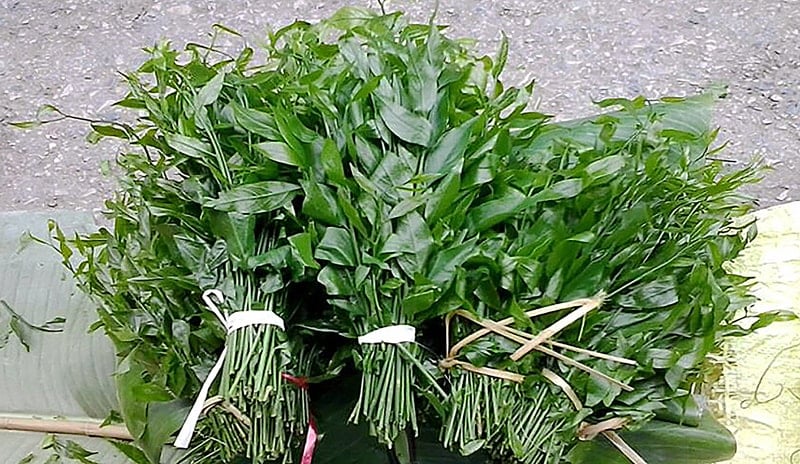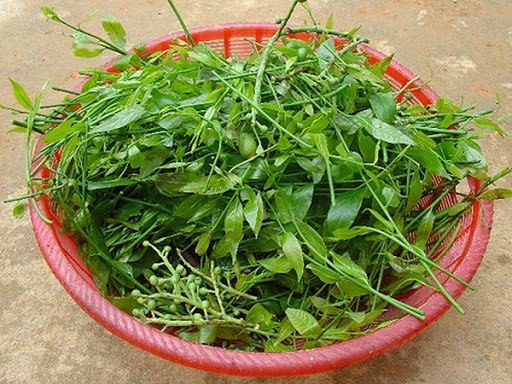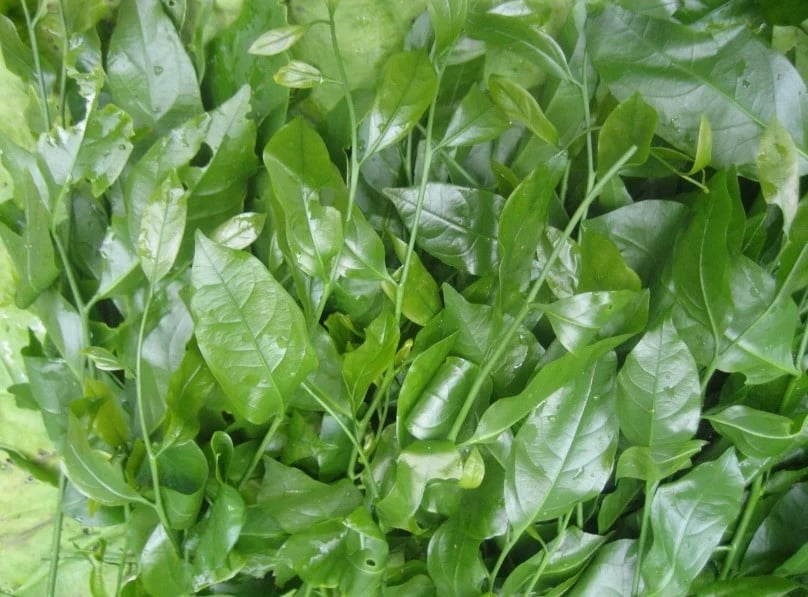Melientha suavis, commonly known as Rau Sang or wild vegetables, is a woody plant that grows naturally in forests, often found on limestone cliffs at an altitude of about 200 meters above sea level. Rau Sang is predominantly distributed in provinces such as Lang Son, Lao Cai, and Quang Ninh. Notably, the Rau Sang tree can grow up to several tens of meters tall, with lush branches and leaves. To harvest the tender shoots and leaves, one often has to climb up these tall trees.
The period from March to April every year marks the time when nature bursts into a foliage of leaves. Among this verdant landscape, Rau Sang stands out with its natural sweetness and distinctive flavor, captivating anyone who has ever tasted it. Since ancient times, the locals have been harvesting and preparing Rau Sang in various delectable boiled and stir-fried dishes.
Today, Rau Sang is not only a popular vegetable but also an expensive delicacy in big cities, favored by consumers. During times of scarcity or at the beginning of the season, the price of Rau Sang in Hanoi can reach up to 180,000 VND/kg, while the flowers of the Rau Sang plant can cost up to 200,000 VND/kg. Typically, the price of Rau Sang ranges from 120,000 to 150,000 VND/kg.

Typically, the price of Rau Sang ranges from 120,000 to 150,000 VND/kg
“In the past, Rau Sang grew wild on the forest edges, and people would only pick it to cook simple dishes,” shared Ms. Hai from Lang Son. “Over time, its delicious taste spread, and everyone wanted to buy and taste it.”
There are currently two types of Rau Sang available in the market: wild Rau Sang and cultivated Rau Sang. The wild variety, with its unique and rare flavor, tends to be significantly more expensive than the cultivated one.
Apart from the vegetable, the flowers of the Rau Sang plant are also a delicacy, often prepared with shrimp, minced meat, or shrimp paste, each dish offering a distinctive and refreshing flavor.
The leaves and young shoots of the Rau Sang plant are a deep green, glossy, and smooth, containing higher protein and amino acid content than many other vegetables. Per 100g of Rau Sang, there are approximately 6.5 to 8.2g of protein, 0.23g of lysine, 0.19g of methionine, 0.08g of tryptophan, 0.25g of phenylalanine, 0.45g of threonine, 0.22g of valine, 0.26g of leucine, and 0.23g of isoleucine, along with 11.5mg of vitamin C and 0.6mg of carotene…

The leaves and young shoots are deep green, glossy, and smooth, containing higher protein and amino acid content.
Rau Sang is not only a delightful vegetable but also highly nutritious, especially beneficial for pregnant women. Traditionally, our ancestors considered Rau Sang more than just a regular vegetable, believing it held medicinal properties to treat issues like allergies, night sweats, and bedwetting in children…
Some notable benefits of Rau Sang include:
– Diuretic, cooling, and detoxifying properties: With its creamy taste and cooling nature, Rau Sang effectively promotes diuresis, detoxifies, and invigorates blood circulation.
– Curing stomatitis: Due to its cooling property, Rau Sang aids in treating stomatitis. If this condition persists for a long time without improvement, simply pound Rau Sang, filter the juice, and drink it for about two days to see significant progress.
– Relieving constipation: Rau Sang, known for its cooling nature, effectively treats constipation. Consuming Rau Sang juice or dishes prepared with this vegetable will help improve intestinal function and benefit the overall digestive system.

Rau Sang effectively treats constipation due to its cooling nature.
– Treating oral thrush in children: Oral thrush in children can cause discomfort and affect their feeding. Rau Sang is an effective solution to this problem. Just pound the Rau Sang, filter the juice, dilute it with honey, and gently apply the mixture to the child’s tongue and throat with a piece of cotton or gauze. The condition will improve after several applications.
– Supporting postpartum women: Rau Sang and its roots stimulate uterine contractions, making it very beneficial for women who have just given birth or experienced a miscarriage.
– Reducing retained placenta: To help postpartum women with retained placenta, pound 40g of Rau Sang, add some cooled boiled water, and filter about 100ml of juice to drink several times a day.
– Supporting weight loss: With its rich fiber, amino acid, vitamin, and compound content, including lysine, protit, methionine, and carotene, Rau Sang effectively supports weight loss, especially for women.






























